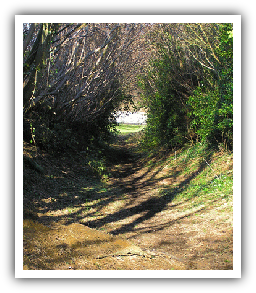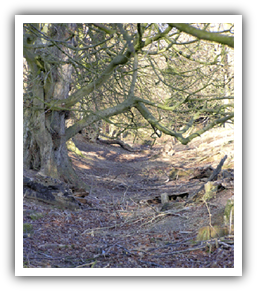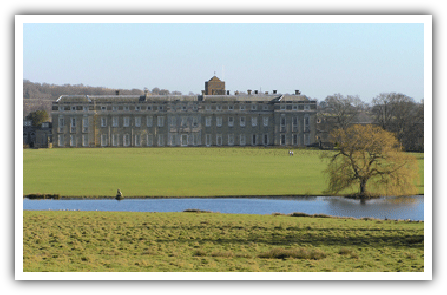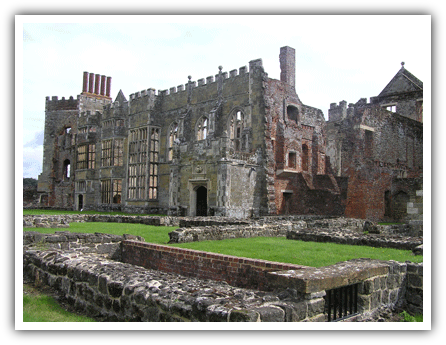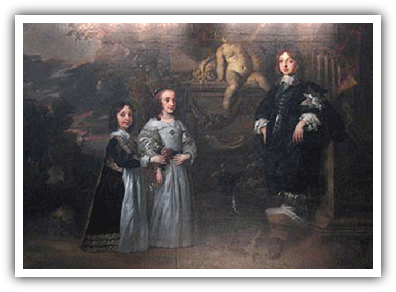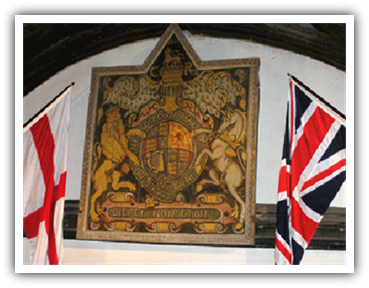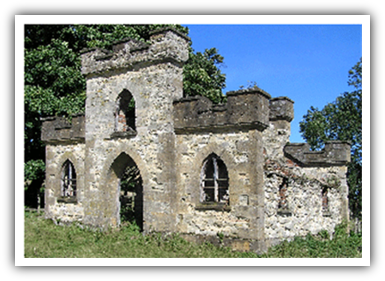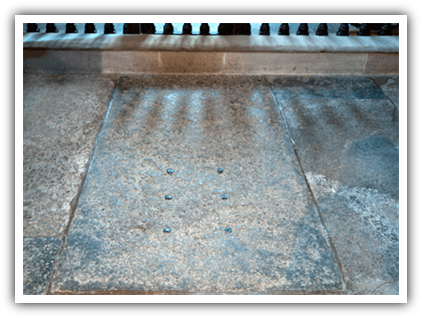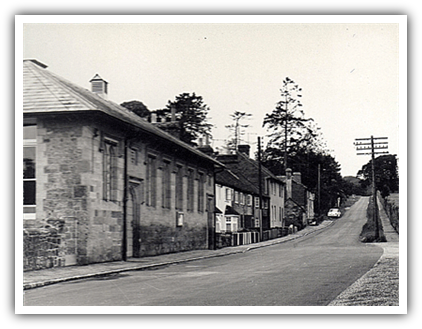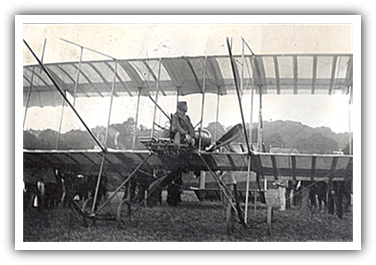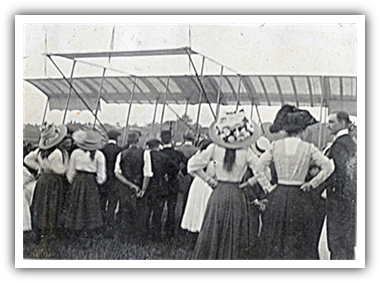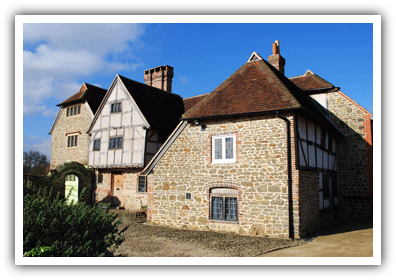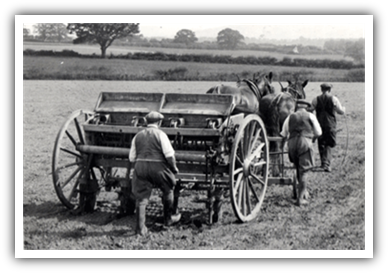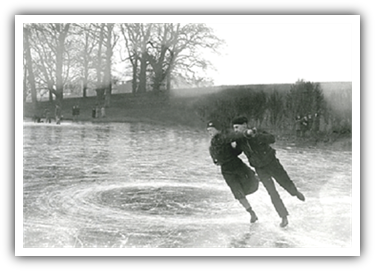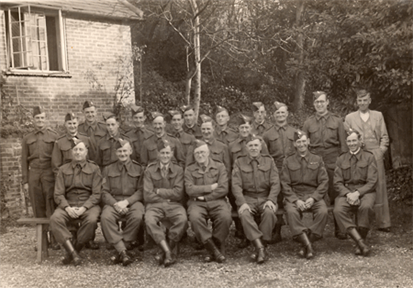





Tillington first comes in to history at the time of Edward the Confessor (1042-1066), with a land value of �8, in the possession of a Lady Eddeva, who held it for the King. In the Domesday Book (1086), � Tolystone� comprised 5 hides (one hide = 120 acres), 7 ploughs, with 8 oxen to one plough, 2 demesnes or farms, one mill, 120 eels, 12 meadows, 20 woods - with 21 villeins, 11 cottagers and 8 serfs; valued at �8.6s.
Sussex villages at this time were small settlements on areas of cultivation cleared from the forests of the Weald. Tillington village lies on a sandstone ridge, with good farmland towards the river Rother. The true Weald begins at River Common, stiff unploughable clay, even today still largely in the wild. The Venerable Bede said of the Weald: �thick and inaccessible, the abode of deer, swine and hogs�.
All Hallows Church is first mentioned around 1100; a simple nave and chancel, with the addition of a square, squat tower in the following century.
In the 13th and 14th centuries several substantial farmhouses of stone, or wattle-and-daub (half-timbered) were built and some remain today including Gretenham (now Grittenham), Sokenholes, The Old Manor House and Little River Farm. Medieval fresco designs have been found preserved in one wall at Sokenholes.
Tillington acquired some importance because of its proximity to Hungers Lane. This is believed to be one of the oldest drove roads in England, from London to the sea.
NOTE
A continuation northward of Hungers Lane can still be seen in the line of trees and ditch just inside Petworth Park, opposite the Almshouses. A close look in the Park paddocks here reveals many traces of previous habitation. (Once part of Tillington)
At Rotherbridge (= Old English �at the bridge of the oxen�) Pastor Acon built a fine cattle bridge around 1200; a bridge is also mentioned in the Domesday Book. It was indeed the hub of the whole area, where meetings of the Hundred, or local Court of Justice, were held. So with the advantages of the river and good farmland, Tillington was already a recognised settlement by 1400.
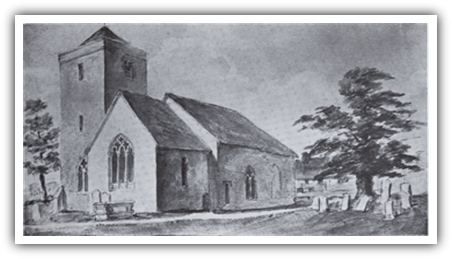
All Hallows Church 1805 (north east corner)
In later medieval times the history of Tillington is bound up with the manors of Petworth, Midhurst and Treve (River). Since the 12th century Petworth has been held by the Percy family, created Earls of Northumberland in 1377, who played a tumultuous part in English history during the medieval period. Of their fortified manor house, the chapel remains, at a skew angle to the present Petworth House, and the cellars under the Carved Room are those that were under the medieval Great Hall. This medieval site accounts for the fortress-like position on the edge of the town that Petworth House occupies today.
In 1299 Edward I passed through Petteworthe and Tillington on his way to Midhurst as feudal overlord of Cowdray. The area was held for the King by the de Bohun family, who also were in possession of the Manor of Treve at River. The first castle was built on St Anne�s Hill, overlooking Midhurst, by Savaric de Bohun in 1135. The foundations that remain are well worth a visit. Later the manor was moved to the nearby meadows where the ruins of Cowdray 'Castle' now stand.
Treve and Tillington were granted to the de la Zouche family (who held other Manors elsewhere, as Ashby de la Zouche in Leicestershire). They made their chief residence at River Park. It is recorded that in 1324 when Edward II came to stay at Petworth, William de la Zouche sent the following for the royal entertainment - 20 flagons of wine, 2 flagons of beer, 2 carcasses of oxen, 6 herons, 4 swans and 94 nuts. The Manor of Treve later passed to the Pelham family. It is also on record that Joan Pelham (widow of Hugh de la Zouche) left 40s in her will of 1439 to All Hallows Tillington.
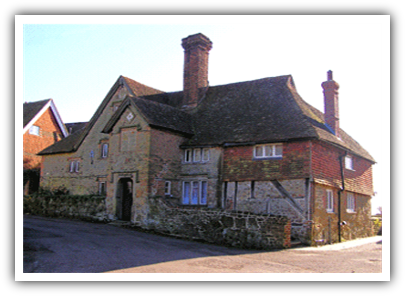
The Old Manor House
Hunger's Lane south of the A272
Continuation of Hunger's Lane in Petworth Park
1
2
Petworth House from the west
Cowdray ruins
4
Three children of Charles I by Lely - Petworth House
The Coat of Arms in All Hallows Church
Map 1
The old Gothic Style 'Colt Shed'
The large 'William Cox' marble slab in the chancel floor of All Hallows
Tillington School c 1960
Basil Barrington-Kennett with his aeroplane
at Tillington
Crowds came out to see the plane
The Smythe drill at Tillington
Skating on Petworth Lake
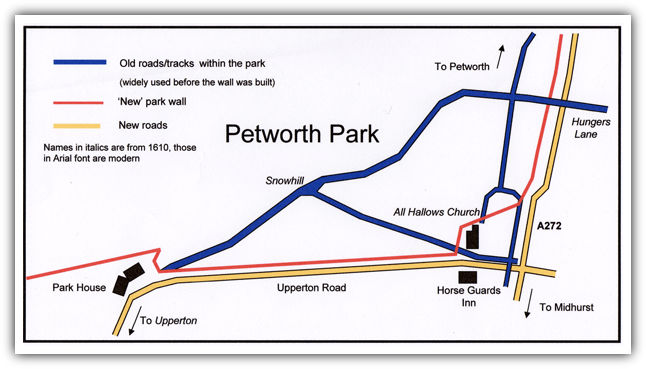
The Tudor Reformation in the sixteenth century plays an important part in Sussex history. The Midhurst-Petworth area was a stronghold of Roman Catholicism, headed by the Percies of Petworth and the Brownes of Cowdray. Their religion was tolerated and three Tudor monarchs paid visits to Cowdray, even the redoubtable Henry VIII. Of a visit in 1552 the young Edward VI wrote : �At Cowdray, a goodlie house of Sir Anthony Browne�s, where we were marvellously, yea rather excessively, banketted.� Browne remained one of the few nobles of his religion whose loyalty was held to be above suspicion. In 1591 he was not too old to entertain Elizabeth I at Cowdray for five days, which included feasting, riding in the park, a fine dinner at Easebourne Priory, and the shooting of deer and hares with arrows.
Less secure in the royal favour was Henry Percy, 8th Earl of Northumberland. Released from prison in 1573 after intrigue with the Catholic Mary Queen of Scots, he was forbidden to return to his estates in the north of England (where his name would carry favour) and so he retired to Petworth. Here he developed more extreme Catholic sympathies and was eventually tried and convicted for his involvement in the Throckmorton plot with the Scots Queen against Elizabeth. With his successor, the 9th Earl, however, the Percy family was reinstated in Elizabeth�s favour in 1585.
There is a record of a Tillington Catholic - John Osborne, yeoman, who was accused and indicted at East Grinstead Assizes for popish recusancy (non-conformism) for one month from 1 June 1590. It seems that this caution was not a deterrent, for we find that in May 1592 he is indicted again. (Calendar of Assize Records for Sussex). Also in these records is mention of one John Flood, labourer of Tillington, who broke into the house of William Langley of Tillington in July 1598 and stole two sheets (worth 2s), two kerchiefs (6d), two shirtbands (3s 4d), a shirt (12d), one apron (12d), a neckerchief (6s), a linen holland band (8d) and half a cheese (4d). On the 18th July evidence was brought before Walter Covert J.P. and William Axtell of Horsham. Flood was found guilty and hanged.
The Tillington parish registers date from 1572. In 1601, with the passing of the Elizabethan Poor Law, according to these registers several poor children were apprenticed to foster parents and arrangements were made for sending vagrants with a whipping back to their home area. Churchwardens� records, with details such as non-attendance at church and popish recusancy, began at this time. The clergy of All Hallows also felt the effects of the Reformation; Alexander Wymseherste was deprived of his living as rector in 1554 by Mary Tudor as punishment for his marriage, allowed in the reign of the Protestant Edward VI. The living of Tillington passed from the Priory and Convent of Lewes (dispossessed at the Dissolution of the Monasteries) into Royal hands.
3
Cowdray had its own associations with the Gunpowder Plot of 1605; Anthony Browne, owner of Cowdray, as Lord Montague, one of the papist peers, had to explain his absence from Parliament on November 5th and was indeed fortunate to be let off with a heavy fine of �4,000, paid to the Court of Star Chamber. He was released upon completion of the payment from the Tower after forty weeks. The 9th Earl of Northumberland was also suspected of complicity in the Plot, but fared worse than Montague; a fine of �11,000, an enormous sum in those days, and imprisonment in the Tower for sixteen years.
After the Civil War broke out, the three youngest children of Charles I came to Petworth under the charge of Algernon Percy, 10th Earl of Northumberland. They were allowed to visit their father in prison (1647), Their portrait, by Sir Peter Lely, hangs in the Oak Staircase Hall at Petworth House. A silver clock, belonging to Charles I, was given as a keepsake to the King�s attendant, Thomas Herbert, on the night before the King�s execution at Whitehall Palace. The clock later passed by marriage into the possession of the Mitford family at Pitshill.
The Civil War soon made itself felt in Tillington. In 1652, the Stuart Arms in the Church were obliterated and those of Parliament put up in place at a cost of 20s. In 1661, following the Restoration, the Stuart Arms were repainted on boards in a moulded and embattled frame by Edward Scales, who was paid �6 3s 6d. Joseph Betts was paid 35s for making the frame and hanging up the arms above the chancel arch, where they are to be seen today. The bells were rung and public thanksgivings were given for Charles II�s coronation; the area had always been significantly Royalist and Catholic in its sympathies.
Between 1688 and 1696, Petworth House was extensively rebuilt by the Duke of Somerset in time to entertain William III there. It was reported by a contemporary however as �not near finished� in 1703. This comes from the account of the visit of the King of Spain to Petworth on the way to Windsor. The royal carriage had the misfortune to stick in the Sussex mud, the last nine miles costing six hours.
5
The eighteenth century saw several alterations and improvements in the communications of the area. Petworth Park was given its present layout, which necessitated road changes between Petworth and Tillington. The map below (Map 1) gives some idea of the new road and park layout.
The line of the A272 as now was established by Capability Brown in 1762 and the present Tillington to Upperton road was built in 1779. As a matter of interest, the Gothic style stabling for brood mares behind the Village Hall was built on the site of an old habitation on the Tillington-Snowhill-Upperton trackway. Upperton was already a thriving community by then, inhabited by tenant copyholders holding plots of land from the Earl of Egremont, William Mitford of Pitshill, Henry Ede and the Somerset Hospital in Petworth. Local names like Pratt, Puttick and Stoner already feature.
The southern approaches to Petworth were improved by an act of 1800, enabling traffic on the turnpike road from Chichester and Duncton to pass by Coultershaw Mill instead of by Rotherbridge which was pulled down. Hungers Lane, the old London road passing through Rotherbridge, went out of use. Attention was also paid to the provision of a suitable water supply for Petworth. In 1782, the third Earl of Egremont installed a forcing engine at Coultershaw for raising water 178 feet to supply the town through iron pipes. He also backed the extensive canalisation schemes of the period, which included rendering the Rother suitable for barge traffic from Hardham and Midhurst. Coal and charcoal were transported upstream, and downstream timber, corn and �Petworth Marble�, then much in demand. The canalised Rother and Arun also proved invaluable before the railway era in transporting agricultural lime from the Duncton chalkpits and Amberley to the clay areas of the Weald.
As a farming community, Tillington itself possessed few local industries of importance, and these on a small scale. The soil is mainly loam, clay and green-sand, difficult to plough with oxen in the 18th and early 19th centuries One mineral, fuller�s earth, was found here; supplies were extensively used for cleaning cloth in the neighbouring fulling mills at Duncton and Haslingbourne near Byworth. Tillington soils had very little lime in them and as a result there were small limekilns in Willetts Lane, using chalk brought from the Rother. Some of the lime fertiliser produced even went by wagon to Blackdown.
Hops were grown locally in the late 18th century. The Earl of Egremont had a flourishing hop ground in Petworth Park, producing malt for the numerous alehouses of Petworth. William Mitford of Pitshill made a reference in 1768 to a husband of one of the Somerset Hospital nurses being active in local hop-growing. Behind the Horse Guards Inn was an old brewery; there are spacious cellars, stables and outhouses in which stood the vats. The brewery was sold to King and Barnes at the turn of the century.
Further afield there were iron and glass-making industries and marble quarrying. The closest ironworks, just on the edge of the Weald, were at Frith and Mitchelpark near Northchapel, a furnace and forge respectively of 16th-17th century date. There were small furnaces in Pheasant copse at one time; the old hammer ponds have been converted into fishponds, but otherwise no trace has been left. A tiny glass furnace, the size of a bread oven, was found in 1931 near Stagpark Farm. The dates of operation were probably 1567 to 1620; the chief glass-worker was a Huguenot Lorrainer, Edward Hanzaye. There is evidence that these French glass-working families were unpopular locally; in 1574 a Petworth Plot to rob, murder and burn their houses, was forestalled.
Petworth Marble was quarried between Petworth and Kirdford until the middle of the nineteenth century. The marble was a freshwater limestone found in Weald clay in seams a few inches, and occasionally two feet, thick. Examples of its use can be seen at Petworth House and in the churches of West Lavington, Northchapel, Lurgashall and Tillington.
The Sussex marble in Tillington chancel floor was probably laid about 1662 or 1663, after the restoration of King Charles II. The middle marble slab is particularly interesting. There has been a brass plaque inlaid in it, the brass rivets are still there but the plaque has been removed to the North wall of the church. This brass is in memory of William Cox a well known local priest. He was a member of the Church of England and although he lived in Petworth he was buried in the chancel floor of All Hallows.
Milling at Coultershaw was a flourishing and profitable business as long as every man was bound by the lord�s rules to grind their corn there. In 1673 William Ede of Churles in Tillington was fined for attempting to bypass this rule - he was found to possess a small quern mill at home.
6
7
The early nineteenth century was for many a time of poverty and distress. Nothing like the Welfare State was in existence. The parish was by law responsible for its poor, and workhouses for this purpose were built and run by boards of guardians. The house of industry to which Tillington paupers under the age of 14 and over 60 were sent was at Easebourne, built in 1792. There were other workhouses at Sutton, Petworth and Wisborough Green. Husbandry, gardening, spinning and weaving, and picking wool were the main employments taken on, and the meagre daily diet for the 159 inmates in 1795 consisted of bread and cheese, or gruel, for breakfast and supper, and meat trimmings for dinner.
In 1799 Lord Egremont�s bounty of clothes, of the best Yorkshire red cloth, was granted to 28 families in Tillington, with 28 children altogether under twelve years old. The adults had to bring two witnesses to prove that they were in honourable employment. Beef and pork pies were distributed from Petworth House at Christmas.
A partial blockade of Britain during the Napoleonic Wars reduced corn imports and forced up the price of bread; the poor often had to fall back on potatoes, barley bread and turnips. By 1815 the conflict was over and cheap corn imports began again. This prompted the introduction of the Corn Laws which offered economic protection to farmers against foreign competition at the expense of the poorer section of the community. An emigration scheme, to try and solve the problem of overcrowding and poverty, was begun for the Petworth area. Some of the emigrants to Canada came from the Little Common district in Tillington (opposite the turning to Southdean Farm). The principal backer of the scheme, Lord Egremont, paid for the passage and provided clothing; a doctor and superintendent travelled on each Petworth ship, and bacon and pork cured in Petworth was added to normal rations of oatmeal, potatoes, herrings, tea, sugar, bread and vinegar. According to an entry in the Tillington parish register in 1836, �40 was borrowed from parish rates to assist the emigration. One new settler wrote back to Petworth to express his gratitude for his new life out in Canada, but how the rest fared we shall never know.
8
Tillington School was built in 1838 (closed 1963) on Pitshill estate land. Originally there was one big room, with a stove in the middle, the boys on one side and the girls on the other, with their own separate entrances. Later a room at the back with a gallery was added for the infant class, and the school extended on the east with big windows installed (the image below shows that it was an impressive building). The playground was on the site of the Linton House garden, with an �extension� into the road which was all quiet then. Often boys were called out in school hours for help with the beaters, potato picking and harvesting as the season demanded. The leaving age was at first ten or eleven, and later thirteen or fourteen. In the Tillington Parish Register of 1906 we find a recommendation by the Parish Council that the leaving age be thirteen instead of fourteen; one reason for this was the number of children in the school, about 100 just before the 1914-18 war. Some children walked from South Lane and River to arrive at school for 9 o�clock.
Many came from Upperton, which in those days had its own grocer and baker (Mr George Hazlett in the 1880�s) and Miss Emily Hazlett was the dressmaker. There was also a pub, the Queen�s Head, kept by a Mr Alfred King. The road through Upperton was a dusty trackway; condition �poor� according to an 1895 survey of roads in the area This same survey described Hunger�s Lane as �very fair� and Cemetery Lane as �moderate�. In 1900 there was a house-to-house collection for the upkeep of these roads. Tolls were still being charged; one River husbandman told of how his fruit happened to be sold in Portsmouth instead of Brighton. The road to Portsmouth had only three toll gates whereas the Brighton road had eight.
The very first aeroplane came into this area in 1911. Lieutenant Basil Barrrington-Kennett of the Royal Flying Corps (who was killed later in the war) brought his biplane to land in the 11 acre field behind Tillington House. Crowds of people turned out, some from church that morning, and many wrote their names on the wings. The Scouts arranged a guard over the machine overnight till very early the next day.
The farmhouse at Grittenham ranks among the oldest buildings in the Tillington area. The manor is mentioned in Domesday Book at �Greteha�, comprising 4 hides and one virgate (one hide roughly 120 acres, a virgate 30 acres) complete with mill, quarry, meadow and woodland with 30 pigs. In the present day farmhouse, foundation beams and corners have been found, also traces of a mullioned window; two separate small dwellings of 14th-15th century date are conjectured.
In 1625 an extension on the south, in good stone, was built onto the 16th century wattle and daub building already incorporating the two small dwellings. The overmantel in the second storey room of this extension has E and IP 1625 - Edward Pratt and his wife, the former appearing in Tillington parish registers as the overseer. Bricked-in windows here testify to the Window Tax of the eighteenth century.
From 1915 Grittenham was farmed for the Pitshill estate by Cuthbert Barham who lived at Little Common Farm. It was his grandfather, Edward Barham, who brought the first Smythe seed drill to Tillington from Suffolk in the middle of the last century. He demonstrated it at the market in Petworth Square and very soon his neighbours were eager to hire or have a copy of his machine. It was a great improvement on the customary hand-worked iron dibble and could easily take the horses used for ploughing. There were seed drills at Southdean and Little Common Farm in use until the early 1980s.
The Bennett family came to Southdean in about 1856 and left in 1872 when Mr George Duck took over, because under estate rules neither a widow nor a young boy could manage the farm. After the Second World War William Bennett returned to live at Southdean - Mr Duck was in his nineties by then and could still be seen daily on horseback round the farm. Up to a great age he woke at 4am to milk the cows and then began the long drive by horse and cart to take the milk to Liss Station for the 7am train to London. He was one of the first farmers to send milk to London from this area, at the time of the Franco-Prussian War in 1870. Until the advent of the lorry and the Milk Marketing Board, William Bennett used to take milk to the station at Petersfield on weekdays and to Midhurst on Sundays. Milk from the Shorthorn herd at Sokenholes would be taken down Hungers Lane and over Rother Bridge to Petworth Station. The Station in earlier days was a rare sight before seven o�clock in the morning when many local horses and carts with milk churns converged on the sport; the station platform was in fact not long enough to accommodate the whole train.
9
10
Over the last 100 years Petworth has had its share of memorable events, including Queen Victoria�s Golden Jubilee in June 1887. A splendid marquee was erected in the Park for the Public Dinner following the Town Parade and Divine Service. There were amusements and dancing afterwards, culminating in a grand Torchlight Procession with the band back to Petworth Square at nine o�clock.
King Edward VII, then Prince of Wales, would have seen the Park in very different colour when he attended a two-day shooting party from Petworth House in early December 1899. He was tolerably pleased with his bag from Pheasant Copse and Stag Park. Local children were more interested in gaining a glimpse of the Prince to the extent of some mischievously scrambling up the bank at Petworth Station.
Thirty years later, in early 1929, Petworth Park was the scene of youthful excitement. An unusually cold spell had frozen over the lake and as soon as Lord Leconfield had pronounced the ice of a proper thickness, many took to skating and ice hockey with turned up walking sticks.
During the Second World War troops for coastal defence were billeted in Pheasant Copse. Foundations of huts are still to be seen there, though now much overgrown. Pitshill Park was the home for a short while of Canadian troops; Queen Elizabeth came here to review these in 1943. Canadian veterans today return annually to Wisborough Green for a service in memory of the Dieppe raid of August 1942, planned and carried out from these parts. The Army also occupied the building at Snowhill inside the Petworth Park wall, now since demolished.
The defence of Tillington in the summer of 1940, when the German invasion from France seemed imminent, was placed under Colonel Sutton, commander of the Local Defence Volunteers, and Colonel Holland the Company Commander. The WVS arranged the accommodation of evacuee children in the parish and the Womens Land Army carried on vital and devoted work on all the local farms; a threshing gang was billeted in Tillington during the War.
Grittenham Farmhouse
Tillington Home Guard 1939/45









